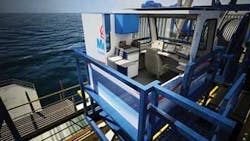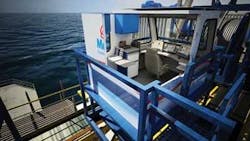Coiled tubing conference showcases new technology
John Waggoner, Technology Editor, Drilling & Production
Some major developments in coiled tubing technology were announced from the floor of the recent SPE/ICoTA conference in The Woodlands, Texas.
The Coiled Tubing & Well Intervention Conference showcased technical papers from a variety of presenters from around the world. Here are some highlights from the show:
Breakthrough storm choke alternative
One of the most talked-about technical sessions was a new BJ Services replacement safety valve system for control lines installed through tubing.
When an operator loses surface control of a well’s subsurface safety valve, conventional remedies can be both expensive and unreliable. This new technology aims to defeat this bugbear for regulators and operators alike.
Presenter Jeff Bolding of BJ Services spoke withOffshore magazine about the technology after his presentation.
“It’s a fairly major development,” Bolding says of regulatory approval from US Minerals Management Service (MMS).
Approval by MMS is particularly relevant since the system is an alternative to restoring well control with a storm choke.
Storm chokes (also known as velocity valves), are what operators turn to when the subsurface safety valve control systems stop working. The MMS approves their installation in US waters reluctantly because storm chokes do not allow for surface control and are riskier than the mandated SCSSVs, especially in wells with erratic flows, Bolding says.
Surface-controlled subsurface safety valves (SCSSVs) are mandatory for offshore wells because of environmental reasons.
Among limitations of storm chokes are that they “choke” production and require expensive periodic maintenance with a rig. In contrast, the new BJ “Reconnect” system can be installed without a rig to restore full, normal surface control to an API-approved safety valve.
Primary (tubing-retrievable) SCSSVs are installed as part of the production string and are designed to stop flow in the event of a catastrophic failure. SCSSVs are held open by positive hydraulic pressure through a control line, typically a ¼-in. (6.4-mm) tube that runs to surface through the annulus between the production tubing and the casing/liner. An emergency shut down depressurizes the control line, so the valve reverts to its “fail-safe” closed position. Re-pressurizing the line opens the valve.
If the integrity of the control line is compromised, it is possible to lose surface control of the SCSSV also. When this happens, generally the operator has to choose from four difficult options:
In extreme cases, the workover required could be fatal for well economics.
The Reconnect system provides a fifth option.
Coming up with and proving a retrofit through-tube solution would work is no easy feat, as detailed in Bolding’s presentation.
Briefly, the system relies on three key components: a modified wireline-retrievable SCSSV, a replacement control line that strings into the new valve assembly, and a wellhead adapter. In the ideal wellhead configuration, all components are landed below the lowest master valve to allow full MMS compliance for upper tree maintenance or replacement.
In a case study presented to support the paper, a mature well in the Gulf of Mexico had developed a leak in the control line for its subsurface safety valve. Injecting sealants did not repair the leak. The operator considered installing a velocity valve, but the well was scheduled for a plug-and-abandonment operation for one zone and perforation of a new zone. Adjusting and re-adjusting a velocity valve for the new zone was expected to be time-consuming and expensive because of the well’s remote location.
Instead, a Reconnect system was installed in August 2008 and tested to ensure compliance with MMS regulations. Since then, the operator has had the flexibility to vary the well’s production rate without the intervention required to pull the velocity valve to adjust the differential pressure settings.
In addition, the operator can perform mandatory testing of the downhole safety valve without the added cost of a liftboat previously required due to the small platform’s limited crane capacity and deck space. For this alone, the system paid for itself after one test, Bolding says.
Merlin has automated controls for coil tubing unit
Another hit on the floor of the show was NOV Hydra Rig’s automated Merlin Control System for coil tubing unit (CTU) operations.
Design modifications include:
The computer system communicates failure to the operator via CTES Orion and Cerberus DAS. The system is built around the Amphion Single Board Computer, a proven SBC developed by NOV for mobile rig control applications.
An important innovation is Merlin’s “self-troubleshooting” feature that monitors the system and notifies the operator of a problem. The system is automated to respond with touch screen controls and joystick override.
Since each component in the system is recognized by part name and number, the operator already knows exactly what intervention is called for. That saves time and reduces the possibility of human error.
Most mundane functions are fully automated in the system, with precise auto-drill functions to reduce operator fatigue.
Machine and job limits can be preset to protect against damage to critical components and to improve job safety performance. The programmable safety logic feature allows the CTU to react automatically to sudden changes in downhole conditions.
The system is installed on the HR 680 injector, and incorporates computer control of traction, tension, brake state, tubing lubrication, and stripper. The system can detect impending chain slippage to help reduce pipe damage. Encoders monitor chain speed and record injector footage for maintenance.
Since the control cabin is “dry” with no high pressure hydraulics, this results in advantages to form. Only one electrical umbilical is needed to connect the cabin to the rest of the CTU, which creates a streamlined feel.
The rigid foam composite shell cabin itself is surprisingly comfortable as well as practical with a wraparound work surface, a rear bench seat with monitoring station, purpose-built climate control, and even room for a small refrigerator. Visibility is excellent from the cabin through large front and side windows.
The hydraulic reel is fully automated and based on the D3000 Drop-In-Drum design. The auto-spooler controls tubing wrap for consistent, even spooling on and off the drum.
Merlin’s power pack is driven by a Caterpillar diesel engine with a 90 GPM closed-loop hydraulic system. Hydraulic lines are stored on reels on the power pack and routed to each component. Onboard power generation is either hydraulic driven or independent engine-driven. An extra control console has been added for complete unit control at the power pack in case of an emergency.
The system also provides for integrated operation of nitrogen and fluid pumping units for single point job control from the Merlin control cabin. A built-in simulator provides off-well training.
Orders pile up for wireless BHA communication system
Impact Guidance Systems (IGS) took advantage of the show to announce toOffshore magazine that the company has taken BHA communications to the next level with a smart wireless system for coil tubing applications.
TheSmartCoil system is the first to allow wireless BHA data transmission and soon will be deployed in dozens of applications starting with three jobs in the Middle East and one in Alaska projected for April, among others.
The modular system instantly converts all IGS data sensors into real-time tools for use while logging, perforating, fishing, or during MLT operations.
The appeal of real time well data is that operators can analyze pressure, temperature, weight on bit (WOB), torque, inclination, CCL, gamma ray, and impact forces without having to pull the coil string to surface.
“This is the first totally wireless system, and already over 60 have been ordered,” says IGS President Stuart McLaughlin.
Initial trials of the technology showed thousands of hours of wellhead intervention can be avoided, McLaughlin says. A case study is pending.

